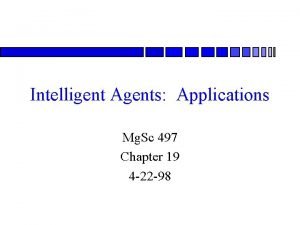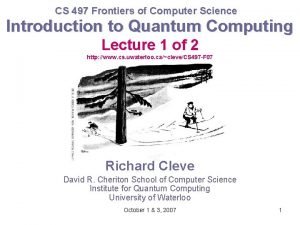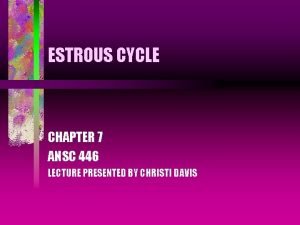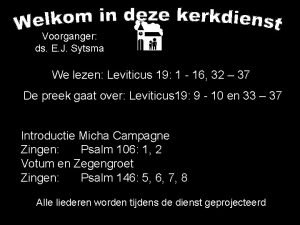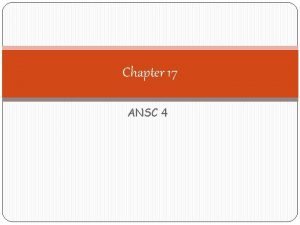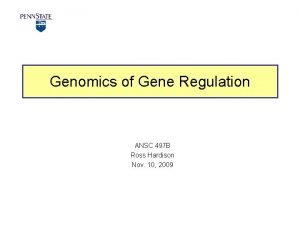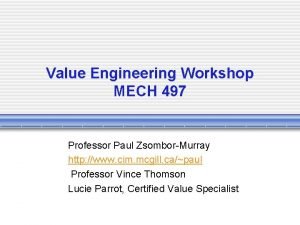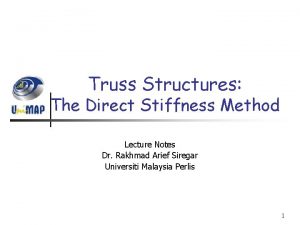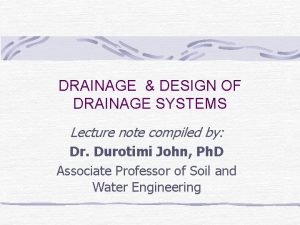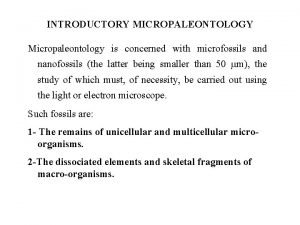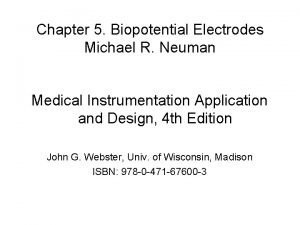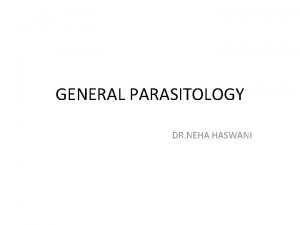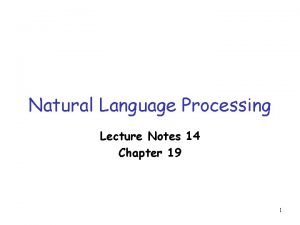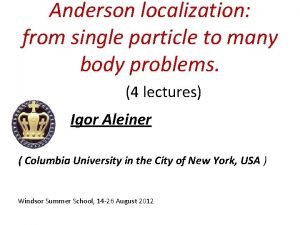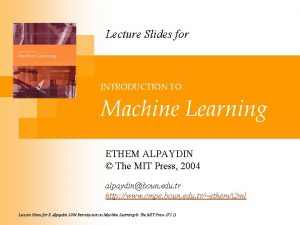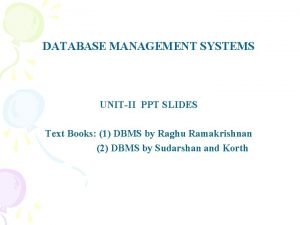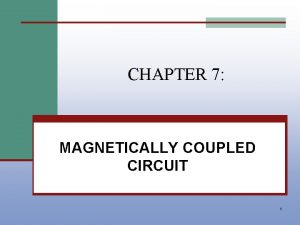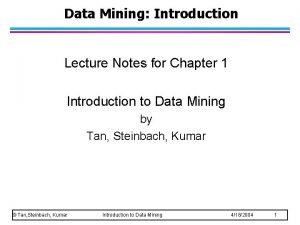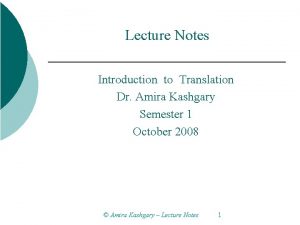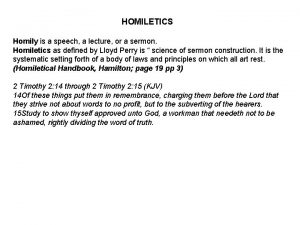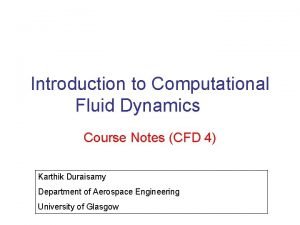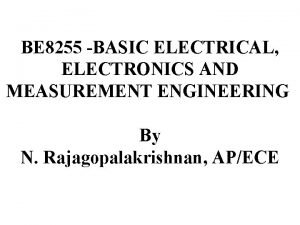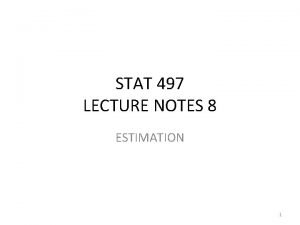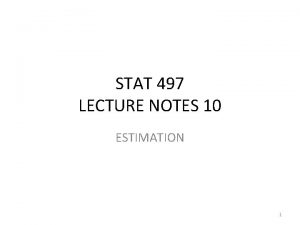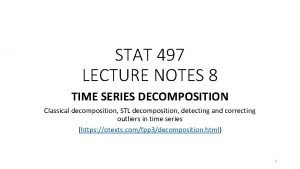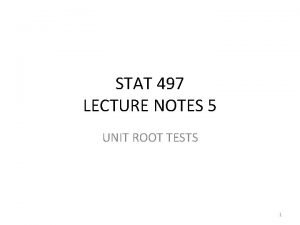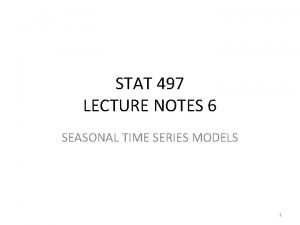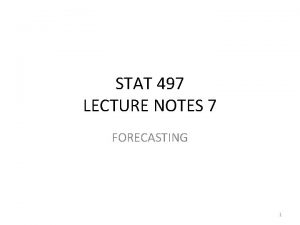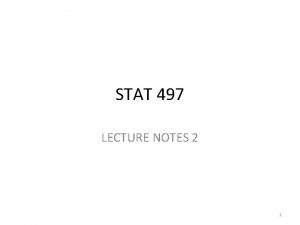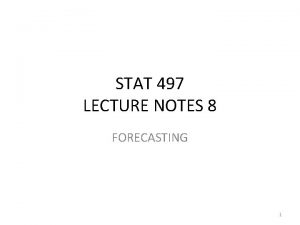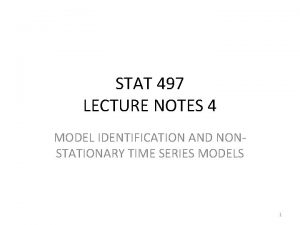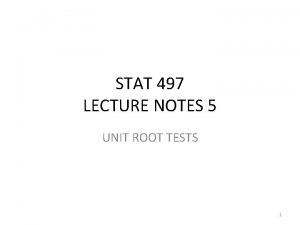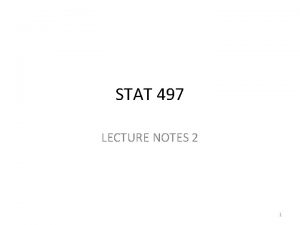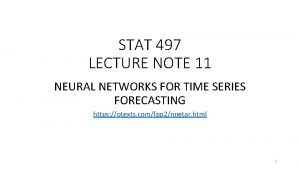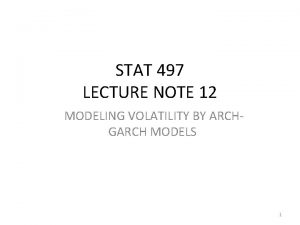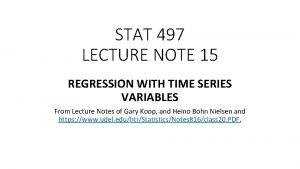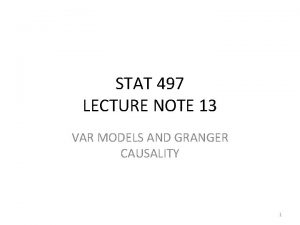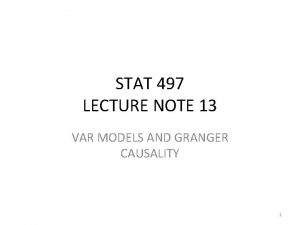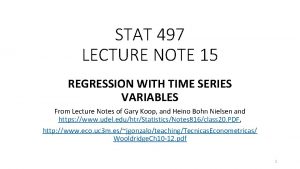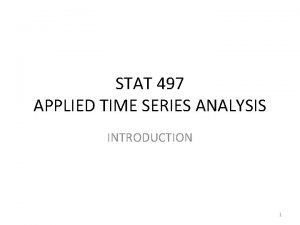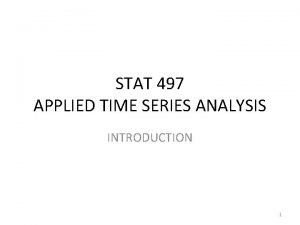STAT 497 LECTURE NOTES 9 ESTIMATION 1 ESTIMATION


















































![Accuracy Comparison MSE_arima=sum(fit 3$res)^2/length(beer) MSE_ets=sum(fit_ets$res)^2/length(beer) print(cbind(MSE_arima, MSE_ets)) MSE_arima MSE_ets [1, ] 0. 03324427 0. Accuracy Comparison MSE_arima=sum(fit 3$res)^2/length(beer) MSE_ets=sum(fit_ets$res)^2/length(beer) print(cbind(MSE_arima, MSE_ets)) MSE_arima MSE_ets [1, ] 0. 03324427 0.](https://slidetodoc.com/presentation_image_h/0de674b10f8a6d867749aec2deeed01f/image-51.jpg)
- Slides: 51

STAT 497 LECTURE NOTES 9 ESTIMATION 1

ESTIMATION • After specifying the order of a stationary ARMA process, we need to estimate the parameters. • We will assume (for now) that: 1. The model order (p and q) is known, and 2. The data has zero mean. • If (2) is not a reasonable assumption, we can subtract the sample mean , fit a zero-mean ARMA model: Then use as the model for Yt. 2

ESTIMATION – Method of Moment Estimation (MME) – Ordinary Least Squares (OLS) Estimation – Maximum Likelihood Estimation (MLE) – Least Squares Estimation • Conditional • Unconditional 3

THE METHOD OF MOMENT ESTIMATION • It is also known as Yule-Walker estimation. Easy but not efficient estimation method. Works for only AR models for large n. • BASIC IDEA: Equating sample moment(s) to population moment(s), and solve these equation(s) to obtain the estimator(s) of unknown parameter(s). 4

THE METHOD OF MOMENT ESTIMATION • Let n is the variance/covariance matrix of X with the given parameter values. • Yule-Walker for AR(p): Regress Xt onto Xt− 1, . . . , Xt−p. • Durbin-Levinson algorithm with replaced by. • Yule-Walker for ARMA(p, q): Method of moments. Not efficient. 5

THE YULE-WALKER ESTIMATION • For a stationary (causal) AR(p) 6

THE YULE-WALKER ESTIMATION • To find the Yule-Walker estimators, we are using, • These are forecasting equations. • We can use Durbin-Levinson algorithm. 7

THE YULE-WALKER ESTIMATION • If {Xt} is an AR(p) process, Hence, we can use the sample PACF to test for AR order, and we can calculate approximate confidence intervals for the parameters. 8

THE YULE-WALKER ESTIMATION • If Xt is an AR(p) process, and n is large, • 100(1 )% approximate confidence interval for j is 9

THE YULE-WALKER ESTIMATION • AR(1) Find the MME of . It is known that 1 = . 10

THE YULE-WALKER ESTIMATION • So, the MME of is • Also, is unknown. • Therefore, using the variance of the process, we can obtain MME of. 11

THE YULE-WALKER ESTIMATION 12

THE YULE-WALKER ESTIMATION • AR(2) Find the MME of all unknown parameters. • Using the Yule-Walker Equations 13

THE YULE-WALKER ESTIMATION • So, equate population autocorrelations to sample autocorrelations, solve for 1 and 2. 14

THE YULE-WALKER ESTIMATION Using these we can obtain the MME of To obtain MME of formula. , use the process variance 15

THE YULE-WALKER ESTIMATION • AR(1) • AR(2) 16

THE YULE-WALKER ESTIMATION • MA(1) • Again using the autocorrelation of the series at lag 1, Choose the root so that the root satisfying the invertibility condition 17

THE YULE-WALKER ESTIMATION • For real roots, If If If , unique real roots but non-invertible. , no real roots exists and MME fails. , unique real roots and invertible. 18

THE YULE-WALKER ESTIMATION • This example shows that the MMEs for MA and ARMA models are complicated. • More generally, regardless of AR, MA or ARMA models, the MMEs are sensitive to rounding errors. They are usually used to provide initial estimates needed for a more efficient nonlinear estimation method. • The moment estimators are not recommended for final estimation results and should not be used if the process is close to being nonstationary or noninvertible. 19

THE MAXIMUM LIKELIHOOD ESTIMATION • Assume that • By this assumption we can use the joint pdf instead of which cannot be written as multiplication of marginal pdfs because of the dependency between time series observations. 20

MLE METHOD • For the general stationary ARMA(p, q) model or 21

MLE • The joint pdf of (a 1, a 2, …, an) is given by • Let Y=(Y 1, …, Yn) and assume that initial conditions Y*=(Y 1 -p, …, Y 0)’ and a*=(a 1 -q, …, a 0)’ are known. 22

MLE • The conditional log-likelihood function is given by Initial Conditions: 23

MLE • Then, we can find the estimators of =( 1, …, p), =( 1, …, q) and such that the conditional likelihood function is maximized. Usually, numerical nonlinear optimization techniques are required. After obtaining all the estimators, where d. f. = of terms used in SS of parameters = (n p) (p+q+1) = n (2 p+q+1). 24

MLE • AR(1) 25

MLE The Jacobian will be 26

MLE • Then, the likelihood function can be written as 27

MLE • Hence, • The log-likelihood function: 28

MLE • Here, S*( ) is the conditional sum of squares and S( ) is the unconditional sum of squares. • To find the value of where the likelihood function is maximized, • Then, 29

MLE • If we neglect ln(1 2), then MLE=conditional LSE. • If we neglect both ln(1 2) and , then 30

MLE • Asymptotically unbiased, efficient, consistent, sufficient for large sample sizes but hard to deal with joint pdf. 31

CONDITIONAL LEST SQUARES ESTIMATION • AR(1) 32

CONDITIONAL LSE • If the process mean is different than zero 33

CONDITIONAL LSE • MA(1) – Non-linear in terms of parameters – LS problem – S*( ) cannot be minimized analytically – Numerical nonlinear optimization methods like Newton-Raphson or Gauss-Newton, . . . *There are similar problem is ARMA case. 34

UNCONDITIONAL LSE • This nonlinear in . • We need nonlinear optimization techniques. 35

BACKCASTING METHOD • Obtain the backward form of ARMA(p, q) • Instead of forecasting, backcast the past values of Yt and at, t 0. Obtain the unconditional log-likelihood function, then obtain the estimators. 36

EXAMPLE • If there are only 2 observations in time series (not realistic) Find the MLE of and . 37

EXAMPLE • US Quarterly Beer Production from 1975 to 1990 library(TSA) library(uroot) library(a. TSA) data(beersales) beer=ts(beersales, start=1975, frequency=12) par(mfrow=c(1, 3)) plot(beer, main='Monthly Beer Sales 1975 to 1990', xlab='Time', ylab='') acf(beer, lag. max=36) pacf(beer, lag. max=36) 38

EXAMPLE (contd. ) Ø library(uroot) Ø hegy. test(beer, deterministic = c(1, 0, 0), lag. method = "BIC", maxlag = 12) HEGY test for unit roots statistic p-value t_1 -2. 2779 0. 1281 t_2 -2. 2102 0. 0185 * F_3: 4 0. 2129 0. 8227 F_5: 6 14. 1673 0 *** F_7: 8 7. 3787 9 e-04 *** F_9: 10 6. 2202 0. 0027 ** F_11: 12 0. 4434 0. 6645 F_2: 12 6. 416 0 *** F_1: 12 6. 3383 0 *** Deterministic terms: constant Lag selection criterion and order: BIC, 2 P-values: based on response surface regressions > CH. test(beer) ------ ---Canova & Hansen test ------ ---Null hypothesis: Stationarity. Alternative hypothesis: Unit root. L-statistic: 0. 817 Critical values: 0. 10 0. 05 0. 025 0. 01 0. 846 1. 01 1. 16 1. 35 39

hegy. test(diff(beer), deterministic = c(1, 0, 0), lag. method = "BIC", maxlag = 12) HEGY test for unit roots statistic p-value t_1 -8. 6882 0 *** t_2 -2. 2368 0. 0159 * F_3: 4 0. 2065 0. 8316 F_5: 6 13. 73 0 *** F_7: 8 7. 2511 0. 0011 ** F_9: 10 6. 0517 0. 0034 ** F_11: 12 0. 4189 0. 6864 F_2: 12 6. 2823 0 *** F_1: 12 12. 5214 0 *** --Deterministic terms: constant Lag selection criterion and order: BIC, 1 P-values: based on response surface regressions 40

hegy. test(diff(beer, 12), deterministic = c(1, 0, 0), lag. method = "BIC", maxlag = 12) statistic p-value t_1 -2. 6702 0. 0518. t_2 -3. 775 1 e-04 *** F_3: 4 16. 8115 0 *** F_5: 6 22. 1817 0 *** F_7: 8 17. 7135 0 *** F_9: 10 15. 5982 0 *** F_11: 12 11. 1838 0 *** F_2: 12 24. 7171 0 *** F_1: 12 24. 5112 0 *** --Signif. codes: 0 ‘***’ 0. 001 ‘**’ 0. 01 ‘*’ 0. 05 ‘. ’ 0. 1 ‘ ’ 1 Deterministic terms: constant Lag selection criterion and order: BIC, 2 P-values: based on response surface regressions 41

EXAMPLE (contd. ) > plot(diff(beer), ylab='First Difference of Beer Production', xlab='Time') > acf(as. vector(diff(beer)), lag. max=36) > pacf(as. vector(diff(beer)), lag. max=36) 42

EXAMPLE (contd. ) > HEGY. test(wts =diff(beer), itsd = c(1, 1, c(1: 3)), regvar = 0, selectlags = list(mode = "bic", Pmax = 12)) ---- ---HEGY test ---- ---Null hypothesis: Unit root. Alternative hypothesis: Stationarity. ---HEGY statistics: Stat. p-value tpi_1 -6. 067 0. 01 tpi_2 -1. 503 0. 10 Fpi_3: 4 9. 091 0. 01 Fpi_2: 4 7. 136 NA Fpi_1: 4 26. 145 NA 43

> fit 1=arima(beer, order=c(0, 1, 1), seasonal=list(order=c(0, 1, 1), period=12)) > fit 1 Coefficients: ma 1 -0. 8883 s. e. 0. 0361 sma 1 -0. 6154 0. 0981 sigma^2 estimated as 0. 357: 335. 21 log likelihood = -165. 6, aic = 44

To check first order overdifferecing To check seasonal fit 1=arima(x, order=c(0, 1, 1), seasonal=list(order=c(0, 1, 1), overdifferecing period=12)) fit 1 Coefficients: ma 1 sma 1 0. 0034 -1. 000 Sign of seasonal overdifferencing s. e. 0. 0578 0. 038 sigma^2 estimated as 1. 607: 638. 8 log likelihood = -317. 4, aic = 45

46

EXAMPLE (contd. ) fit 1=arima(beer, order=c(3, 1, 0), seasonal=list(order=c(2, 0, 0), period=12) fit 1 Coefficients: ar 1 -0. 5079 s. e. 0. 0796 ar 2 -0. 2535 0. 0846 ar 3 0. 0548 0. 0746 sigma^2 estimated as 0. 4441: sar 1 0. 6657 0. 0738 sar 2 0. 2469 0. 0786 log likelihood = -203. 56, aic = 417. 11 fit 2=arima(beer, order=c(3, 1, 2), seasonal=list(order=c(1, 0, 1), period=12)) fit 2 Coefficients: ar 1 ar 2 1. 0363 -0. 0977 s. e. 0. 1028 0. 1055 ar 3 -0. 2302 0. 0905 sigma^2 estimated as 0. 3411: ma 1 -1. 7846 0. 0785 ma 2 0. 8230 0. 0732 sar 1 0. 9754 0. 0183 log likelihood = -179. 52, sma 1 -0. 6183 0. 1164 aic = 373. 03 47

> fit 2=arima(beer, order=c(3, 1, 4), seasonal=list(order=c(2, 1, 1), period=12)) > fit 2 Coefficients: ar 1 ar 2 ar 3 0. 4832 0. 1634 -0. 8272 s. e. 0. 0939 0. 1258 0. 0934 sar 2 sma 1 -0. 3199 -0. 6998 s. e. 0. 0972 0. 1307 sigma^2 estimated as 0. 2588: ma 1 -1. 2107 0. 0783 ma 2 0. 0877 0. 1491 ma 3 1. 1191 0. 1452 log likelihood = -141. 6, ma 4 -0. 8587 0. 0739 sar 1 0. 3855 0. 1263 aic = 303. 19 48

Forecasting forecast=predict(fit 3, n. ahead = 12) LCI=ts(forecast$pred 1. 96*forecast$se, start=1991, frequency=12) UCI=ts(forecast$pred+1. 96*forecast$se, start=1991, frequency =12) plot(fitted(fit 3), lty=3, n 1=1991, n. ahead=12, main='', xlim=c( 1975, 1992), ylim=c(10, 20)) lines(forecast$pred, col="blue", lty=5, lwd=2) lines(beer) lines(LCI, col="3", lty=3) lines(UCI, col="3", lty=3) 49

Forecasting library(forecast) fit_ets <- ets(beer) fit_ets Smoothing parameters: alpha = 0. 1138 beta = 2 e-04 gamma = 1 e-04 phi = 0. 98 sigma: 0. 5807 AICc BIC 818. 9508 822. 9046 877. 5857 fc <- forecast(fit_ets) plot(fc) 50
![Accuracy Comparison MSEarimasumfit 3res2lengthbeer MSEetssumfitetsres2lengthbeer printcbindMSEarima MSEets MSEarima MSEets 1 0 03324427 0 Accuracy Comparison MSE_arima=sum(fit 3$res)^2/length(beer) MSE_ets=sum(fit_ets$res)^2/length(beer) print(cbind(MSE_arima, MSE_ets)) MSE_arima MSE_ets [1, ] 0. 03324427 0.](https://slidetodoc.com/presentation_image_h/0de674b10f8a6d867749aec2deeed01f/image-51.jpg)
Accuracy Comparison MSE_arima=sum(fit 3$res)^2/length(beer) MSE_ets=sum(fit_ets$res)^2/length(beer) print(cbind(MSE_arima, MSE_ets)) MSE_arima MSE_ets [1, ] 0. 03324427 0. 1303638 51
 01:640:244 lecture notes - lecture 15: plat, idah, farad
01:640:244 lecture notes - lecture 15: plat, idah, farad Mg 497
Mg 497 Cs 497
Cs 497 Ansc 497
Ansc 497 Opwekking 497 tekst
Opwekking 497 tekst Ansc 497
Ansc 497 Ansc 497
Ansc 497 Paul zsombor-murray
Paul zsombor-murray Direct stiffness method truss
Direct stiffness method truss Lecture notes tiu
Lecture notes tiu Project cost management lecture notes
Project cost management lecture notes Electricity and magnetism lecture notes
Electricity and magnetism lecture notes Power system dynamics and stability lecture notes
Power system dynamics and stability lecture notes Obstetrics and gynecology lecture notes ppt
Obstetrics and gynecology lecture notes ppt Micropaleontology definition
Micropaleontology definition Project quality management lecture notes
Project quality management lecture notes Ic fabrication
Ic fabrication Mechatronics notes
Mechatronics notes Biopotential electrodes lecture notes
Biopotential electrodes lecture notes General parasitology lecture notes
General parasitology lecture notes Exploratory data analysis lecture notes
Exploratory data analysis lecture notes Tiu lecture notes medical analysis
Tiu lecture notes medical analysis Research methodology lecture notes doc
Research methodology lecture notes doc Intermediate microeconomics lecture notes
Intermediate microeconomics lecture notes Theology proper lecture notes
Theology proper lecture notes Network management principles and practice
Network management principles and practice Polynomial regression least squares
Polynomial regression least squares Environmental sociology lecture notes
Environmental sociology lecture notes Natural language processing lecture notes
Natural language processing lecture notes Software engineering lecture notes
Software engineering lecture notes Anderson localization lecture notes
Anderson localization lecture notes Lecture notes tiu
Lecture notes tiu Healthmis.ng
Healthmis.ng Data mining lecture notes
Data mining lecture notes Natural language processing lecture notes
Natural language processing lecture notes Introduction to biochemistry lecture notes
Introduction to biochemistry lecture notes Ethem alpaydin
Ethem alpaydin Physics 111 lecture notes
Physics 111 lecture notes River routing and reservoir routing
River routing and reservoir routing Introduction to database management system ppt
Introduction to database management system ppt Magnetically coupled circuits lecture notes
Magnetically coupled circuits lecture notes Data mining lecture notes
Data mining lecture notes Translation lecture notes
Translation lecture notes Cmos vlsi design lecture notes
Cmos vlsi design lecture notes Lecture notes on homiletics
Lecture notes on homiletics Catalysis lecture notes
Catalysis lecture notes Cfd notes
Cfd notes Ternology
Ternology Slidetodoc.com
Slidetodoc.com Computer-aided drug design lecture notes
Computer-aided drug design lecture notes Be8255 ppt
Be8255 ppt Professional ethics in engineering notes
Professional ethics in engineering notes

